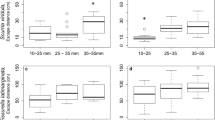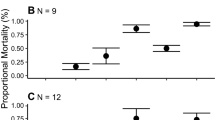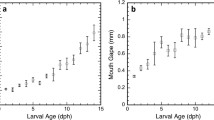Abstract
On many sea shores of the Niedersachsen coast, the polychaete Scolelepis squamata is the dominant animal species living in the sediment of exposed beaches.The population of the predatory species Eteone longa, with a main distribution in more sheltered intertidal and subtidal habitats, has a certain overlap with S. squamata. In these restricted areas, S. squamata suffers from a permanent pursuit by E. longa during low tide. Field and laboratory studies have revealed that this predator-prey relationship follows a distinct behavioural pattern and is an exploitation of surviving animals: the predator does not ingest the whole prey individual but only feeds on regenerable parts of the body. Both species draw characteristic tracks on the sediment surface that illustrate the phases of the chase, the attempts at defence and the mutilation of the prey species.



Similar content being viewed by others
References
Behrends G, Michaelis H (1977) Zur Deutung der Lebensspuren des Polychaeten Scolelepis squamata. Senckenbergiana Mar 9:47–57
Chlebovich VV (1959) A new occurrence of predatious behaviour in a polychaete worm. Priroda 9:118 (in Russian)
Dauer DM (1983) Functional morphology and feeding behavior of Scolelepis squamata (Polychaeta: Spionidae). Mar Biol 77:279–285
Dörjes J, Michaelis H, Rhode B (1986) Long-term studies of macrozoobenthos in intertidal and shallow subtidal habitats near the island of Norderney (East Frisian coast, Germany). Hydrobiologia 142:217–232
Grotjahn M, Liebezeit G (1997) Risk of beach nourishment for the foreshore and shallow shoreface benthic communities on the island of Norderney, Germany. Commission of the European Community; Risk analysis of coastal nourishment techniques (RIACON)
Meyer M, Michaelis H (1980) Das Makrobenthos des westlichen “Hohen Weges”. Jbr 1979 Forschungsstelle Norderney 31:91–155
Michaelis H (1969) Makrofauna und Vegetation der Knechtsandwatten. Jbr 1967 Forschungsstelle Norderney 19:147–173
Michaelis H (1971) Beobachtungen über die Mäander von Scolecolepis squamata. Nat Mus 101:501–506
Michaelis H (1987) Bestandsaufnahme des eulitoralen Makrobenthos im Jadebusen in Verbindung mit einer Luftbildanalyse. Jbr 1986 Forschungsstelle Norderney 38:13–97
Michaelis H, Böhme B (1994) Benthosforschung im ostfriesischen Wattenmeer. Umweltbundesamt (UBA) Texte 24/94
Michaelis H, Wolff WJ (2001) Soft-bottom fauna of a tropical (Banc d’Arguin,Mauritania) and a temperate (Juist area, German North Sea coast) intertidal area. In: Reise K (ed) Ecological comparisons of sedimentary shores. Springer, Berlin Heidelberg New York, pp 255–274
Richter R (1924) Flachseebeobachtungen zur Paläontologie und Geologie. IX. Zur Deutung rezenter und fossiler Mäanderfiguren. Senckenbergiana 6:141–157
Riisgard HU, Kamermans P (2001) Switching between deposit and suspension feeding in coastal zoobenthos. In: Reise K (ed) Ecological comparisons of sedimentary shores. Springer, Berlin Heidelberg New York, pp 73–101
Schubert A, Reise K (1986) Predatory effects of Nephtys hombergii on other polychaetes in tidal flat sediments. Mar Ecol Prog Ser 34:117–124
Seilacher A (1953a) Der Brandungssand als Lebensraum in Gegenwart und Vorzeit. Nat Volk 83:263–272
Seilacher A (1953b) Studien zur Palichnologie. I. Über die Methoden der Palichnologie. Neues Jahrb Mineral Geol Paläontol Abh 96:421–452
Seilacher A, Hemleben C (1966) Beiträge zur Sedimentation und Fossilführung des Hunsrückschiefers 14. Spurenfauna und Bildungstiefe der Hunsrückschiefer (Unterdevon). Notizbl Hess Landesamtes Bodenforsch Wiesbaden 94:40–53
Simon J (1965) Feeding in the annelid Eteone heteropoda. Q J Fla Acad Sci 28:270–271
Stecher J, Dörjes J (1993) Das Makrozoobenthos im Vorfeld der Insel Spiekeroog. I. Saisonale Siedlungsstrukturen im Foreshore-Bereich. Senckenbergiana Mar 23:49–66
Vennemann L (1986) Studien zur Biologie und Ökologie des auf Brandungsbiotope spezialisierten Polychaeten Scolelepis squamata. Thesis, University of Osnabrück
Vlas J de (1979a) Annual food intake by plaice and flounder in a tidal flat area in the Dutch Wadden Sea, with special reference to consumption of regenerating parts of macrobenthic prey. Neth J Sea Res 13:117–153
Vlas J de (1979b) Secondary production by tail regeneration in a tidal flat population of lugworms (Arenicola marina) cropped by flatfish. Neth J Sea Res 13:362–393
Vlas J de (1985) Secondary production by siphon regeneration in a tidal flat population of Macoma balthica. In: Vlas J de, Weide van Vlees. Thesis, University of Groningen
Wincierz J (1973) Küstensedimente und Ichnofauna aus dem oberen Hettangium von Mackendorf (Niedersachsen). Neues Jahrb Mineral Geol Paläont Abh 144:104–141
Witte F, Wilde PAW de (1979) On the ecological relation between Nereis diversicolor and juvenile Arenicola marina. Neth J Sea Res 13:394–405
Wohlenberg E (1937) Die Wattenmeer-Lebensgemeinschaften im Königshafen von Sylt. Helgol Wiss Meeresunters 1:1–92
Acknowledgements
We are indebted to Dr. Sandra Jaklin, Hermann Bick and Dr. Gerhard Cadée for their critical discussion and reading of the manuscript.
Author information
Authors and Affiliations
Additional information
Communicated by O. Kinne, Oldendorf/Luhe
Rights and permissions
About this article
Cite this article
Michaelis, H., Vennemann, L. The “piece-by-piece predation” of Eteone longa on Scolelepis squamata (Polychaetes )—traces on the sediment documenting chase, defence and mutilation. Marine Biology 147, 719–724 (2005). https://doi.org/10.1007/s00227-005-1595-8
Received:
Accepted:
Published:
Issue Date:
DOI: https://doi.org/10.1007/s00227-005-1595-8




